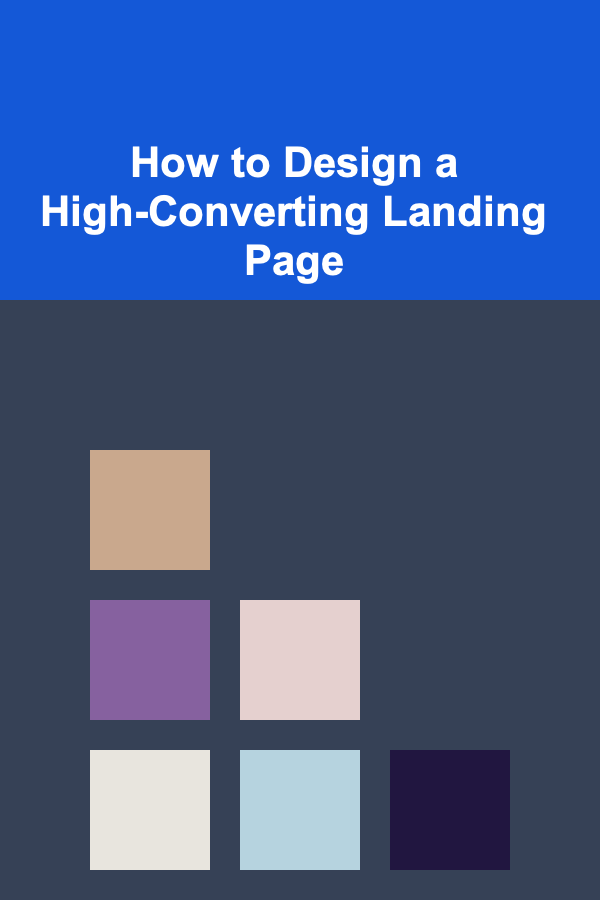
How to Design a High-Converting Landing Page
ebook include PDF & Audio bundle (Micro Guide)
$12.99$7.99
Limited Time Offer! Order within the next:

In the ever-evolving digital landscape, a well-designed landing page is paramount for successful online marketing campaigns. It's the crucial bridge between your marketing efforts and your conversion goals, whether that's generating leads, driving sales, or acquiring new customers. A high-converting landing page isn't just about aesthetics; it's about strategically crafted content, a user-centric design, and a deep understanding of your target audience. This article delves into the intricacies of creating a landing page that not only attracts visitors but also compels them to take the desired action.
Understanding the Purpose of a Landing Page
Before diving into the design elements, it's essential to grasp the fundamental purpose of a landing page. Unlike a regular website page, which typically serves multiple purposes and provides a broad overview of a business, a landing page is laser-focused on a single, specific objective. This objective might be:
- Lead Generation: Capturing contact information (e.g., email address, phone number) from potential customers.
- Direct Sales: Encouraging visitors to purchase a product or service directly from the page.
- Subscription Sign-Ups: Convincing users to subscribe to a newsletter, blog, or membership program.
- Event Registration: Motivating people to register for a webinar, conference, or other event.
- App Downloads: Driving users to download a mobile application.
- Free Trial Sign-Ups: Offering a free trial of a software or service.
The clarity of this single purpose is the foundation of a successful landing page. Everything on the page, from the headline to the call-to-action (CTA), should be aligned with and contribute to achieving this objective.
Key Takeaway:
A landing page is a standalone webpage designed with a single, focused objective in mind. Its entire design and content should be optimized to drive conversions related to that specific goal.
Key Elements of a High-Converting Landing Page
A high-converting landing page comprises several key elements that work together to guide visitors toward conversion. These elements are not just about aesthetics; they are strategic components designed to address visitor needs, build trust, and ultimately, motivate action.
1. Compelling Headline and Subheadline
The headline is the first thing visitors see, and it must grab their attention and immediately convey the value proposition. It should be clear, concise, and relevant to the offer. A strong headline:
- Highlights the primary benefit: What problem does your product or service solve? How will it improve the visitor's life or business?
- Uses keywords: Incorporate keywords that your target audience is likely to use when searching for solutions like yours.
- Creates a sense of urgency or exclusivity (when appropriate): Words like "Limited Time Offer" or "Exclusive Access" can entice visitors to act quickly.
The subheadline serves as a supporting statement, elaborating on the headline and providing further context. It can expand on the benefits, address potential objections, or provide additional details about the offer.
Example:
Headline: Double Your Website Traffic in 30 Days
Subheadline: Get proven SEO strategies and personalized guidance to boost your rankings and attract more customers.
2. High-Quality Visuals
Visuals play a crucial role in attracting attention and conveying information quickly. Choose images or videos that are relevant to your offer, visually appealing, and professionally produced. Consider the following:
- Relevance: Ensure visuals directly relate to the product, service, or offer being promoted. Avoid generic stock photos that don't add value.
- Quality: Use high-resolution images and videos that are clear, sharp, and well-composed. Blurry or pixelated visuals can damage your credibility.
- Emotional Connection: Choose visuals that evoke the desired emotions and resonate with your target audience. Showcasing happy customers using your product, for instance.
- Demonstration: Videos can be particularly effective for demonstrating how your product or service works and highlighting its key features.
Consider using images of real people, especially if they are representative of your target audience. This can help build trust and create a stronger connection with visitors.
3. Clear and Concise Copy
Your landing page copy should be clear, concise, and persuasive. Avoid jargon and technical terms that your target audience might not understand. Focus on the benefits of your offer, rather than just listing features.
- Focus on Benefits: Highlight how your product or service will solve the visitor's problems and improve their lives. Use "you" language to address the visitor directly.
- Keep it Concise: Respect the visitor's time and attention. Get straight to the point and avoid unnecessary fluff. Use bullet points and short paragraphs to make the copy easy to scan.
- Use Strong Verbs: Choose action-oriented verbs that encourage action (e.g., "Get Started," "Download Now," "Claim Your Discount").
- Address Objections: Anticipate potential objections that visitors might have and address them proactively in your copy. For example, if you're offering a free trial, you might address concerns about automatic billing after the trial period.
- Social Proof: Include testimonials, reviews, or case studies to build trust and credibility. Seeing that others have had positive experiences with your product or service can significantly increase conversion rates.
4. Compelling Call-to-Action (CTA)
The call-to-action (CTA) is the most critical element of your landing page. It's the button or link that you want visitors to click on to take the desired action. A well-designed CTA is:
- Visually Prominent: The CTA should stand out from the rest of the page, using contrasting colors and a clear, easy-to-read font.
- Action-Oriented: Use strong action verbs that clearly indicate what will happen when the visitor clicks (e.g., "Get Your Free Ebook," "Start Your Free Trial," "Request a Demo").
- Benefit-Driven: Reiterate the benefit of taking action in the CTA text (e.g., "Download Your Free Guide to Increased Productivity").
- Strategically Placed: Place CTAs above the fold (visible without scrolling) and strategically throughout the page, especially after key benefits or features have been highlighted.
- Mobile-Friendly: Ensure that the CTA is easily clickable on mobile devices. Make it large enough to tap with a finger.
A/B test different CTA variations (text, color, size, placement) to see what performs best with your target audience.
5. Minimalist Design
A cluttered and confusing landing page can overwhelm visitors and distract them from the primary goal. A minimalist design focuses on simplicity and clarity, guiding the visitor's eye to the most important elements.
- Whitespace: Use ample whitespace (negative space) to create visual breathing room and make the page easier to scan.
- Clear Hierarchy: Use headings, subheadings, and bullet points to organize the content and guide the visitor's eye through the page.
- Limited Navigation: Ideally, a landing page should have no navigation menu or limited navigation options to minimize distractions and keep visitors focused on the conversion goal.
- Consistent Branding: Maintain consistent branding (colors, fonts, logo) to create a cohesive and professional look and feel.
The goal of a minimalist design is to remove any unnecessary elements that could distract visitors from the CTA.
6. Social Proof and Trust Signals
Building trust is crucial for converting visitors. Incorporate social proof and trust signals to demonstrate the credibility and value of your offer.
- Testimonials: Include genuine testimonials from satisfied customers. Ideally, use testimonials that are specific and highlight the benefits that customers have experienced. Include photos of the customers, if possible.
- Reviews: Display positive reviews from third-party review sites (e.g., Google Reviews, Yelp, Trustpilot).
- Case Studies: Showcase successful case studies that demonstrate how your product or service has helped other customers achieve their goals.
- Logos of Clients: Display logos of well-known clients that you have worked with.
- Security Badges: Include security badges from trusted security providers to reassure visitors that their information is safe and secure.
- Guarantees and Warranties: Offer guarantees or warranties to reduce risk and build confidence. For example, a money-back guarantee can be very effective in overcoming hesitation.
The more trust signals you can incorporate, the more likely visitors are to convert.
7. Mobile Optimization
With the majority of internet users accessing websites on mobile devices, it's crucial to ensure that your landing page is fully optimized for mobile. A mobile-friendly landing page should:
- Be Responsive: Use a responsive design that automatically adjusts to different screen sizes and resolutions.
- Load Quickly: Optimize images and videos to reduce loading times. Mobile users are less patient and more likely to abandon a page that takes too long to load.
- Have a Clear CTA: Ensure that the CTA is easily visible and clickable on mobile devices. Make it large enough to tap with a finger.
- Use Large Fonts: Use larger fonts that are easy to read on smaller screens.
- Simplify Forms: Keep forms short and simple to minimize typing on mobile devices. Use auto-fill features whenever possible.
Test your landing page on different mobile devices to ensure that it looks and functions correctly.
8. A/B Testing and Optimization
A/B testing (also known as split testing) is the process of comparing two versions of a landing page to see which one performs better. This is an essential step in optimizing your landing page for maximum conversion rates.
- Test One Element at a Time: To accurately measure the impact of each change, test only one element at a time (e.g., headline, CTA, image).
- Use a Control Group: Keep one version of your landing page as the control group and compare the performance of the other versions against it.
- Run Tests for a Sufficient Period: Run tests for a sufficient period (e.g., one to two weeks) to gather enough data to make statistically significant conclusions.
- Use A/B Testing Tools: Use A/B testing tools like Google Optimize, Optimizely, or VWO to track and analyze the results of your tests.
- Iterate and Improve: Continuously iterate and improve your landing page based on the results of your A/B tests.
Common elements to A/B test include:
- Headlines and Subheadlines
- Call-to-Action (text, color, size, placement)
- Images and Videos
- Form Fields
- Page Layout
- Pricing and Offers
Key Takeaway:
A/B testing is crucial for optimizing your landing page. By systematically testing different variations of your page elements, you can identify what resonates best with your audience and drive higher conversion rates.
Designing for Specific Goals
The specific design and content of your landing page will depend on your primary goal. Here's a look at how to tailor your landing page for different objectives:
Lead Generation Landing Page
The primary goal of a lead generation landing page is to capture contact information from potential customers. This often involves offering something of value in exchange for their contact details, such as a free ebook, whitepaper, webinar, or consultation.
- Compelling Offer: The offer must be valuable and relevant to your target audience. It should address their specific needs or pain points.
- Clear Value Proposition: Clearly communicate the benefits of receiving the offer. What will the visitor gain from downloading the ebook, attending the webinar, or receiving the consultation?
- Simple Form: Keep the form short and only ask for the essential information. The more fields you require, the lower your conversion rate will be. Consider using progressive profiling to gradually collect more information over time.
- Privacy Policy: Include a link to your privacy policy to reassure visitors that their information will be kept confidential.
Example:
Headline: Download Your Free Guide to Generating More Leads with Content Marketing
Subheadline: Learn proven strategies for creating valuable content that attracts leads and drives sales.
Form: Name, Email Address, Company Name
CTA: Download Now
Direct Sales Landing Page
The goal of a direct sales landing page is to convince visitors to purchase a product or service directly from the page.
- High-Quality Product Images/Videos: Showcase your product or service with high-quality images and videos that highlight its key features and benefits.
- Detailed Product Descriptions: Provide detailed product descriptions that explain the features and benefits of your product or service. Address any potential questions or concerns that visitors might have.
- Pricing and Payment Options: Clearly display the price of your product or service and offer a variety of payment options.
- Money-Back Guarantee: Offer a money-back guarantee to reduce risk and build confidence.
- Urgency and Scarcity: Create a sense of urgency or scarcity to encourage visitors to act quickly. For example, you might offer a limited-time discount or highlight the limited availability of your product.
Example:
Headline: Get 20% Off Our Premium Marketing Automation Software
Subheadline: Automate your marketing tasks and save time and money.
Product Image: Showcase screenshots of the software and its key features.
Price: Regular Price: $99/month. Sale Price: $79/month.
CTA: Buy Now and Save 20%
Subscription Sign-Up Landing Page
The objective here is to get visitors to subscribe to your newsletter, blog, or membership program.
- Highlight the Benefits: Clearly communicate the benefits of subscribing. What will subscribers receive? Will they get exclusive content, discounts, or early access to new products?
- Show Examples of Content: Provide examples of the type of content that subscribers will receive. This can help visitors understand the value of subscribing.
- Social Proof: Show the number of subscribers you already have. This can create social proof and encourage others to subscribe.
- Easy Sign-Up Form: Keep the sign-up form simple and only ask for the email address.
Example:
Headline: Subscribe to Our Newsletter and Get the Latest Marketing Tips
Subheadline: Get actionable insights and strategies to grow your business.
Example Content: Share snippets of your best newsletter content.
Social Proof: "Join 10,000+ marketers who already subscribe."
CTA: Subscribe Now
Beyond the Design: Optimizing for the User Experience
While the design elements are crucial, a high-converting landing page also prioritizes the user experience. A positive user experience can significantly impact conversion rates.
- Page Load Speed: Optimize your landing page for speed. Use tools like Google PageSpeed Insights to identify areas for improvement. Faster loading pages lead to better engagement and lower bounce rates.
- Mobile-Friendliness: As previously mentioned, ensure your page is fully responsive and provides a seamless experience on all devices.
- Accessibility: Make your landing page accessible to people with disabilities. Use appropriate alt text for images, provide captions for videos, and ensure that the page is navigable with a keyboard.
- Clear Value Proposition Above the Fold: Ensure the core value proposition is immediately visible without requiring the user to scroll.
- Minimize Distractions: Avoid unnecessary pop-ups, animations, or other elements that could distract visitors from the main goal.
Conclusion
Designing a high-converting landing page is an iterative process that requires careful planning, execution, and optimization. By understanding the key elements of a successful landing page, tailoring your design to specific goals, and prioritizing the user experience, you can create a powerful tool for driving conversions and achieving your marketing objectives. Remember to continuously test and refine your landing pages based on data and user feedback to maximize their effectiveness. A well-crafted landing page is not just a destination; it's a journey carefully designed to guide visitors towards taking the desired action and ultimately, achieving your business goals.

How to Manage Your Pet's Weight and Prevent Obesity
Read More
How to Set Up a Paperless Office Environment
Read More
How to Set Up an Emergency Fund for Home Expenses
Read More
How to Store Herbs and Spices for Maximum Flavor
Read More
How To Explore the Future of Genetic Medicine
Read More
How to Explore Exoplanets and the Search for Life
Read MoreOther Products

How to Manage Your Pet's Weight and Prevent Obesity
Read More
How to Set Up a Paperless Office Environment
Read More
How to Set Up an Emergency Fund for Home Expenses
Read More
How to Store Herbs and Spices for Maximum Flavor
Read More
How To Explore the Future of Genetic Medicine
Read More